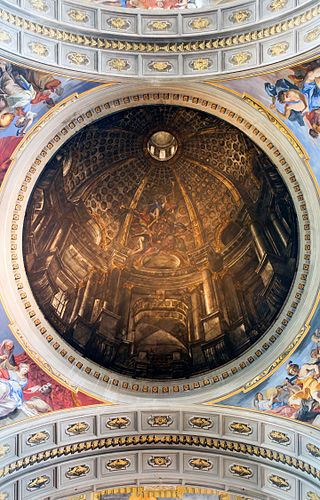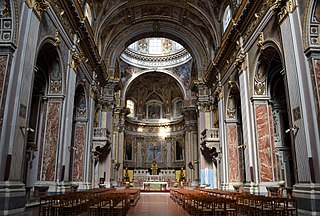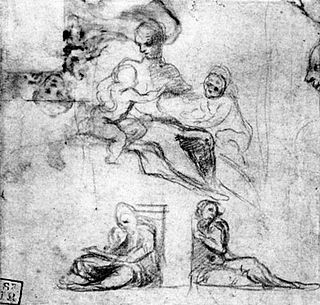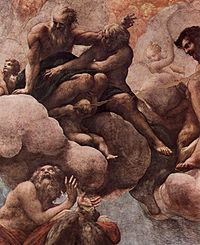
Sisto Badalocchio Rosa was an Italian painter and engraver of the Bolognese School.

Antonio Allegri da Correggio, usually known as just Correggio was an Italian Renaissance painter who was the foremost painter of the Parma school of the High Italian Renaissance, who was responsible for some of the most vigorous and sensuous works of the sixteenth century. In his use of dynamic composition, illusionistic perspective and dramatic foreshortening, Correggio prefigured the Baroque art of the seventeenth century and the Rococo art of the eighteenth century. He is considered a master of chiaroscuro.

In architecture, a pendentive is a constructional device permitting the placing of a circular dome over a square room or of an elliptical dome over a rectangular room. The pendentives, which are triangular segments of a sphere, taper to points at the bottom and spread at the top to establish the continuous circular or elliptical base needed for a dome. In masonry the pendentives thus receive the weight of the dome, concentrating it at the four corners where it can be received by the piers beneath.

Giovanni Battista Gaulli, also known as Baciccio or Baciccia, was an Italian artist working in the High Baroque and early Rococo periods. He is best known for his grand illusionistic vault frescos in the Church of the Gesù in Rome, Italy. His work was influenced by Gian Lorenzo Bernini.

Illusionistic ceiling painting, which includes the techniques of perspective di sotto in sù and quadratura, is the tradition in Renaissance, Baroque and Rococo art in which trompe-l'œil, perspective tools such as foreshortening, and other spatial effects are used to create the illusion of three-dimensional space on an otherwise two-dimensional or mostly flat ceiling surface above the viewer. It is frequently used to create the illusion of an open sky, such as with the oculus in Andrea Mantegna's Camera degli Sposi, or the illusion of an architectural space such as the cupola, one of Andrea Pozzo's frescoes in Sant'Ignazio, Rome. Illusionistic ceiling painting belongs to the general class of illusionism in art, designed to create accurate representations of reality.

Giovanni Lanfranco was an Italian painter of the Baroque period.

Giovanni Maria Francesco Rondani was an Italian painter, active in a Renaissance style in Parma.

The Assumption of the Virgin is a fresco by the Italian Late Renaissance artist Antonio da Correggio decorating the dome of the Cathedral of Parma, Italy. Correggio signed the contract for the painting on November 3, 1522. It was finished in 1530.

Cesare Aretusi was an Italian painter of the late-Renaissance period.

Paolo Toschi was an Italian draughtsman and engraver. He was born in Parma.

San Giovanni Evangelista is a Mannerist-style, Roman Catholic church located on Piazzale San Giovanni, located just behind the apse of the Parma Cathedral, in the historic center of Parma, northern Italy. The buildings surrounding the piazza were also part of a former Benedictine convent. The church is notable for its Correggio frescoes.

Santi Apostoli is a Baroque-style church in Naples, Italy.

The Santissima Annunziata, also called the Basilica del Paradiso, is a Renaissance style, Roman Catholic church and convent located on Via Massimo D'Azeglio in Parma, Italy.

San Paolo is a former convent in central Parma, Emilia-Romagna, northern Italy. It is best known for housing the Camera di San Paolo, decorated by a masterpiece of fresco work (1519) by Correggio.

The Camera di San Paolo or Camera della Badessa is a room in the former Monastery of San Paolo, in Parma, northern Italy. It is painted with frescoes by Correggio in the vault (697x645 cm) and over the fireplace.

The Casalmaggiore Madonna is a lost oil-on-canvas painting by the Italian Renaissance painter Correggio, measuring 28 by 24 cm and painted around 1522.

The Annunciation is a 157 by 315 cm fresco fragment by Correggio, dating to around 1524-1525 and now in the Galleria nazionale di Parma.

The Lamentation of Christ is an oil on canvas painting by the Italian Renaissance artist Correggio, dating from around 1524 and housed in the Galleria Nazionale of Parma, Italy.

Mystic Marriage of Saint Catherine or Mystic Betrothal of Saint Catherine is a c.1524 oil on canvas painting by the Italian Renaissance painter Parmigianino. The work is now in the Galleria nazionale di Parma. Art historians argue that the work may be attributed to the period in which Parmigianino was painting his first works in the church of San Giovanni Evangelista, as also emerges from a recent restoration, which has shown that its technique is near-identical to that of Parmigianino - "no underdrawing, pigment use, descriptive speed, drafting of final shadows, using fingers and brush-ends as tools".
San Giovannino, or the Roman Catholic church of San Giovanni Evangelista is a religious building is located on the narrow Piazzetta San Giovanni in the historic center of Reggio Emilia, region of Emilia Romagna, Italy. The church is best known for the frescoes by early Baroque painters.























